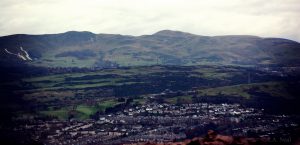As human beings, it has always been, and will always be in our nature to ask questions, to travel far and wide, seeking out our individual purpose in a vastly changing world. Lately, though, much of that soul searching is conducted online instead of on a mountain.
With the advent of social media, Earth has become a much smaller place. Digital communications have made it easier to see and hear the world around us, the adventures taken by others, the horrors of war, and the rise of hate in our own backyards.
It’s fitting that “all that was once directly lived has now become mere representation,” a spectacle and nothing more according to French philosopher and theorist Guy Debord, has become truth. And we’ve accepted that and are content in knowing it.
Now, why do I say all this? Because there comes a point when we must all find a quiet place—a place away from the internet stimulants poisoning our souls.
For me, like many others, that place lies far above sea level, where the air is crisp, thin, and devoid of sound. The elements around you are pure, and the sporting competition is between you and the barely visible mountain tops.
And yes, in case you’re wondering, hiking, mountaineering, rock climbing, and beyond, while not traditional sports—they lack certain elements of competition—still meets the dictionary definition of a “sport.”
No applause or trophy awaits you at the top. You alone gaze out into the distance, rewarded only by the beauty and splendor of a pink-hued setting sun.

The McDowell Mountain’s a sacred place to the Yavapai people. Now a popular destination for hiking tourists, it was my escape from the noise of holiday commercialism.
The dusty winding trail is dotted with tan-colored stones, small critter burrows and cacti as far as I could see. Rustling branches accompanied the sing songs of quail, hidden by the desert underbrush, and fresh javelina (wild boar) tracks led me to the mountain’s peak, where I contemplated the words of John Muir: “Keep close to nature’s heart…and break clear away once, in a while, and climb a mountain or spend a week in the woods. Wash your spirits clean.”

The Rise of Mountain Climbing as a Sport
From the dawn of time, or at least the dawn of superstition, mountains have held an historically spiritual significance.
Mount Olympus, home of the Greek Gods; Mount Sinai, a scared place in Judaism, Mount Kailash home of the Hindu deity Shiva; Arthur’ Seat in Edinburgh, Scotland, a marker for the fabled city of Camelot; Mount Taranaki, a place of worship for the Taranaki peoples of New Zealand; the list goes on and on.



It should come as no surprise then, that our quest to find knowledge and seek the heavens led to our climbing of mountains.
“To-day I made the ascent of the highest mountain in this region, which is not improperly called Ventosum. My only motive was the wish to see what so great an elevation had to offer,” wrote Francesco Petrarch, Italian Renaissance poet and scholar, after climbing Mount Ventoux on April 26, 1336.
“At first, owing to the unaccustomed quality of the air and the effect of the great sweep of view spread out before me, I stood like one dazed. I beheld the clouds under our feet.”
While not the first recorded mountain-top journey in history, Petrarch’s letter gives us a glimpse at how, even then, the awe-inspiring beauty of nature fills us with a sense of peace and gratification.
The “golden age” of mountain climbing as a sport can be traced back to 1854, when English mountaineer Alfred Wills ascended the Wetterhorn—making the sport “fashionable,” which led to the first mountaineering organization, the Alpine Club, in 1857.
Science and exploration merged during this period and was capped by the first successful climb of the Matterhorn in 1865 by English illustrator Edward Whymper.
During the 1800s in the United States, Edwin James climbed Pikes Peak in the Colorado Rockies, John C. Freemont tackled the highest frozen peak in Wyoming, and the U.S. Military reached Pico de Orizaba, the tallest peak in Mexico, in 1842.
Today, the sport is governed by the International Climbing and Mountaineering Federation (UIAA). Founded in Chamois, France in 1932, the UIAA’s role goes beyond representing climbers and competition. It organizes the annual UIAA Ice Climbing World Cup and biannual World Championship and Youth World Championship.
http://https://www.youtube.com/watch?v=mhGxfwi8-eI
Environmental sustainability is a significant part of UIAA’s mission. The UIAA’s activities focus on:
Promoting sustainable mountain regions development and rewarding innovative initiatives in adventure tourism and mountain conservation.
Raising awareness about environmental issues and furthering education on mountain preservation and sustainable practice.
Supporting concrete actions taken by our federations that aim to preserve the mountain environment in its natural state.
Encouraging the adoption and respect by all international declarations, including UIAA’s own ethical guidelines, in order to preserve mountain ecosystems and cultures.
Liaising with international organizations on access and conservation issues and aiding, when requested, to member federations on such issues within their own countries.
Of course, beyond environmental protection lies the issue of gentrification and displacement of indigenous people for the sake of adventure tourism.
Romanticizing Adventure and Its Negative Effects
Located between Mexico and Guatemala is the small Central American country of Belize, home to the Maya people, who have lived in the area for over 4,000 years.
Covering close to three million square miles across four countries—Guatemala, Belize, Honduras, and El Salvador—the Maya were the most sophisticated and well-developed Mesoamerican civilization.
For over three principal periods (Preclassic, Classic and Postclassic), Maya people built complex and architecturally stunning interconnected cities. The earliest settlements in Belize dating back around 2600 BCE.
Contact was made by the Spanish in 1511, and good relations between the two was short-lived, eventually leading to Spain’s military conquest of the Maya kingdom.
These days, Belize has become a hub of eco- and adventure tourism. Thousands of people travel to hike and scale the mountainsides and ancient ruins.
The Cockscomb Basin Wildlife Sanctuary and Jaguar Preserve, a popular site nestled within a Maya Ceremonial area, the Chucil Baluum, is where a good friend of mine spent part of her winter vacation.
“It was absolutely gorgeous, and everyone was so helpful and nice,” Selena said. She was calling to catch up and talk through our different hikes over the break.
It wasn’t the location, or the natural beauty that stuck in her mind. It was the people.
“When we went to the Jaguar preserve,” she continued, “one of the guides was part of the Maya people and lived in this remote forest his entire life.”
“He had a home, was raising his family, and living off the land, happily…then, came displacement. The government forced them to leave everything behind as they began construction. One morning it was quiet. The next bulldozers were everywhere.”
As Selena and her family hiked through the preserve, she passed the old man’s home. Set far back behind the tree line, it’s a sad reminder of what effects our wanting of adventure has on those who live in the places we visit.
While Belize seems well off thanks to its tourism revenue, the Maya people are constantly under economic threat. The state provides no financial support to Maya farmers, and the government, since the ’90s, has granted land to foreign logging companies.
Our Actions have Consequences
Since our entry into the new world, those consequences have mainly affected indigenous communities. But it doesn’t stop there. As more cities turn to replacing outdated infrastructures with bike routes, trails, etc. to transform and attract new homeowners and businesses, long-term residents are feeling squeezed out of what was once their place through the process of gentrification.
While film and television may leave us yearning for the game of adventure and exploration—for me it was Indiana Jones—we should also keep our impact in mind…not just on the environment, but the people, too.
And with that, please, go “wash your spirit clean.” Race against time and friends in a friendly, rock-climbing competition. Lace up those hiking shoes (if you need new ones check out Summit Creek) and go outside. There’s much we can learn away from the daily distractions.













